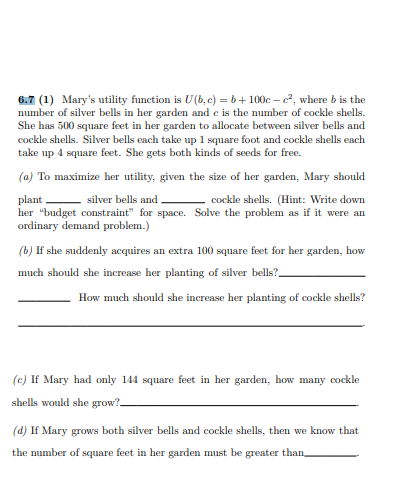6.7 (1) Mary's utility function is U(b.c) = b+100c -e, where b is the number of silver bells in her garden and e is the number of cockle shells. She has 500 square feet in her garden to allocate between silver bells and cockle shells. Silver bells each take up 1 square foot and cockle shells each take up 4 square feet. She gets both kinds of seeds for free. (a) To maximize her utility, given the size of her garden, Mary should - silver bells and. plant her "budget constraint" for space. Solve the problem as if it were an ordinary demand problem.) cockle shells. (Hint: Write down (b) If she suddenly acquires an extra 100 square feet for her garden, how much should she increase her planting of silver bells? How much should she increase her planting of cockle shells? (c) If Mary had only 144 square feet in her garden, how many cockle shells would she grow?
6.7 (1) Mary's utility function is U(b.c) = b+100c -e, where b is the number of silver bells in her garden and e is the number of cockle shells. She has 500 square feet in her garden to allocate between silver bells and cockle shells. Silver bells each take up 1 square foot and cockle shells each take up 4 square feet. She gets both kinds of seeds for free. (a) To maximize her utility, given the size of her garden, Mary should - silver bells and. plant her "budget constraint" for space. Solve the problem as if it were an ordinary demand problem.) cockle shells. (Hint: Write down (b) If she suddenly acquires an extra 100 square feet for her garden, how much should she increase her planting of silver bells? How much should she increase her planting of cockle shells? (c) If Mary had only 144 square feet in her garden, how many cockle shells would she grow?
Chapter6: Demand Relationships Among Goods
Section: Chapter Questions
Problem 6.13P
Related questions
Question
100%

Transcribed Image Text:6.7 (1) Mary's utility function is U(b, c) = b+ 100c – c, where b is the
number of silver bells in her gardem and e is the number of cockle shells.
She has 500 square feet in her garden to allocate between silver bells and
cockle shells. Silver bells each take up 1 square foot and cockle shells each
take up 4 square feet. She gets both kinds of seeds for free.
(a) To maximize her utility, given the size of her garden, Mary should
plant
her "budget constraint" for space. Solve the problem as if it were an
ordinary demand problem.)
silver bells and
cockle shells. (Hint: Write down
(b) If she suddenly acquires an extra 100 square feet for her garden, how
much should she increase her planting of silver bells?_
How much should she increase her planting of cockle shells?
(c) If Mary had only 144 square feet in her garden, how many cockle
shells would she grow?-
(d) If Mary grows both silver bells and cockle shells, then we know that
the number of square feet in her garden must be greater than
Expert Solution
This question has been solved!
Explore an expertly crafted, step-by-step solution for a thorough understanding of key concepts.
This is a popular solution!
Trending now
This is a popular solution!
Step by step
Solved in 2 steps with 1 images

Knowledge Booster
Learn more about
Need a deep-dive on the concept behind this application? Look no further. Learn more about this topic, economics and related others by exploring similar questions and additional content below.Recommended textbooks for you

